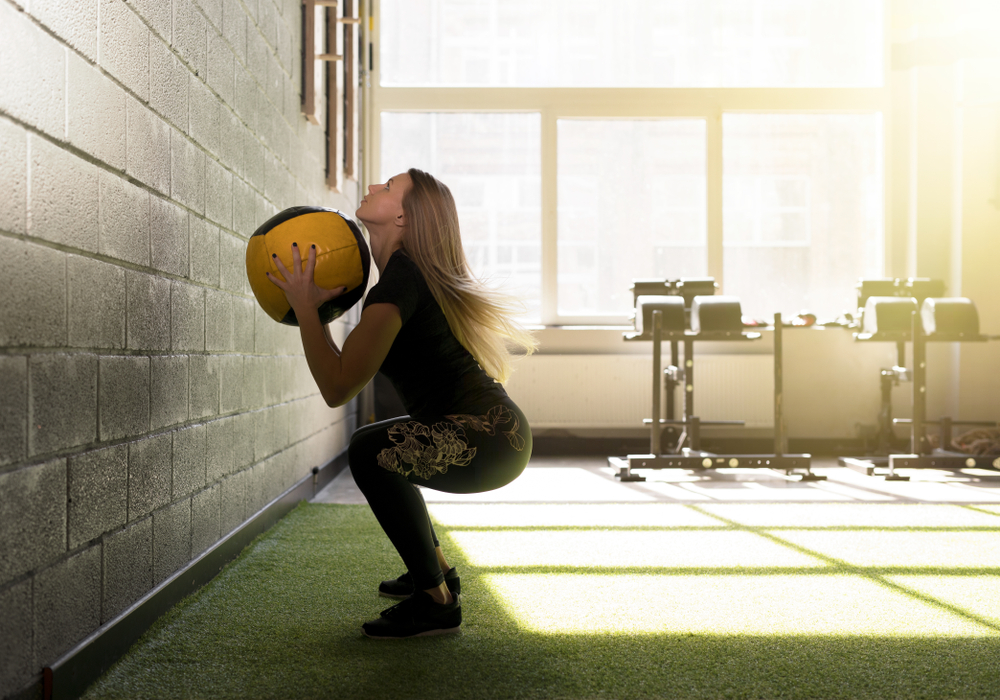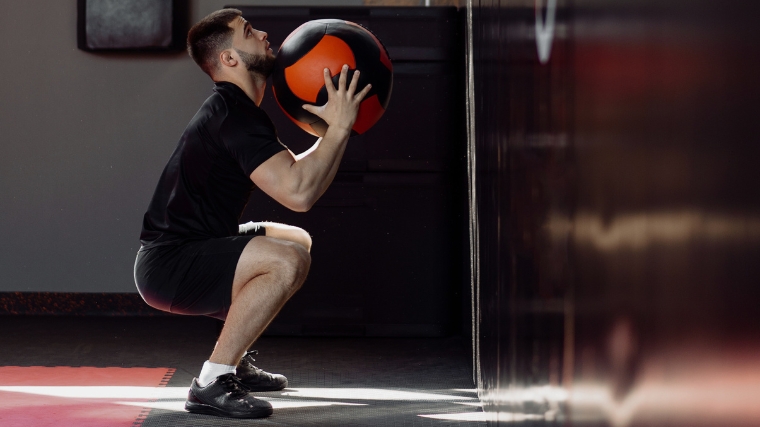You can’t talk about powerlifting workouts without mentioning the deadlift. And what are strongman competitions without some type of stone event? In CrossFit, the name of the game is unpredictability — but there are still some powerful benchmarks that are all but synonymous with the sport itself.
Karen is one such WOD (workout of the day). Comprised of one movement and one movement only, Karen is a rite of passage in CrossFit. You’ll do 150 reps of wall ball shots, as quickly as possible. It’s that simple. And it’s also that difficult. Even for experienced CrossFitters, Karen can bring on unprecedented levels of soreness and mental anguish.

That many reps of one movement is a lot, especially when that movement taxes you from (over)head down to your toes. Here’s what you need to know to survive the CrossFit Karen workout — and how to bring your wall ball game to a whole new level.
- What Is the Karen Workout?
- What Are Good Karen Times?
- Strategies for the Karen Workout
- How to Scale Karen for Beginners
- How to Scale Karen for Intermediates
- How to Scale Karen for Advanced Athletes
Editor’s Note: The content on BarBend is meant to be informative in nature, but it should not be taken as medical advice. When starting a new training regimen and/or diet, it is always a good idea to consult a trusted medical professional. We are not a medical resource. The opinions and articles on this site are not intended for use as diagnosis, prevention, and/or treatment of health problems. They are not substitutes for consulting a qualified medical professional.
What Is the Karen Workout?
If you want to test your endurance and prove your mental toughness with minimal time and equipment, make Karen your new go-to. Introduced as a benchmark WOD on the CrossFit website in 2008, this workout consists of one exercise and one exercise only — the notorious wall ball shot.
Karen calls for 150 wall ball shots, all done as quickly as possible. This is a hefty workload for your entire body. Your legs will be absolutely roasted; your core will be exhausted from supporting such intense ups and downs; your upper back and arms will be not-so-lightly toasted; and your heart and lungs will go through a big cardio effort. Such is the effectiveness of Karen: just one movement is incredibly effective all across your body and fitness level.
Here’s the workout itself, laid out in all its simplicity:
The Workout
For time:
- 150 Wall Ball Shots
Women: 14-pound medicine ball, nine-foot target | Men: 20-pound medicine ball, 10-foot target*
*CrossFit allows trans athletes to compete with their cisgender peers but does not currently have any provisions for nonbinary athletes.
Athletes of any gender can opt for a different weight or height of their choice. But always make sure you’re taking note of precisely how you’re scaling the workout so that you can know how to compare your performance next time.
What Are Good Karen Times?
The time it takes athletes to complete Karen is tremendously based on skill, experience level, and how strategic an athlete is in planning their workout. Even the most advanced athlete can come out of the gate too fast and burn out. Slow and steady often wins this race.
But that doesn’t mean that absurdly fast Karen times don’t happen. For example, Polish CrossFitter Magdelena Kroliowska has been recorded pulling off Karen in a lightning-fast time of 3:56. You can check it out below:
What’s a fast Karen time for you to aim for? Consider these benchmarks below:
- Elite: under four and a half minutes
- Advanced: between four and a half and seven minutes
- Intermediate: between seven and 12 minutes
- Beginner: over 12 minutes
Strategies for the Karen Workout
While it’s simple on paper, Karen will take the wind out of you. It’s not only about your legs, though those will start yelling quickly. Karen requires you to stay calm, regulate your breath, and maintain solid form with an overwhelming amount of reps. You’ll also have to listen to your body and stick with a realistic assessment of your abilities instead of leading with your ego.
This makes Karen a great workout for getting in touch with yourself as an athlete. You’ll have to make smart decisions before your workout and during it, too. Here’s how.
Pace Yourself
You might come out of the gate super fast. But once you’ve polished off that first powerful set of 40, your time may ultimately be longer if you’re barely eking through three or four rep sets for the rest of the workout.
One way to set a pace for yourself is to test out your wall ball shot capacity before launching in. How many reps can you do without needing longer than a 10-second rest to come back relatively fresh? Maybe that number is 10. In that case, make a plan to do 15 sets of 10. Take 10 seconds of rest between each set.
[Read More: The Best Leg Exercises for Your Next Leg Day]
But just because you’ve made a plan doesn’t mean you can’t break it. Maybe you planned to do 10 sets of 15 but didn’t sleep well last night. If after the first couple of sets, you’re fatigued and want to take more than 10 seconds to recover, that’s a sign to shake up your game plan. Shift to sets of 10 instead to keep your pacing steady instead of completely burning out.
Breathe Consistently
When the rigors of Karen start catching up with you, you’re going to want to gasp for your breath. Don’t. As much as possible, try to take slow, deep breaths between sets. If you can, try to take as many of these breaths through your nose as you can. These slower breaths can help regulate your body and aid your recovery from one set to the next.
If your only recourse for breathing between sets is to gasp for air, you’ll want to adjust course and slow down. Take a longer break between this set and your next, and then shave some reps off your future sets so they’re arranged in smaller segments. The goal is to be able to be as in control of your breathing as you can be to maximize recovery and stamina.
Keep Track of Your Reps
As a CrossFitter, you’re used to counting reps. But 150 is quite a big number. Even if you’ve divided your work into sets of five, you’ll still have to keep track of 30 total sets.

Make a plan for keeping track of the numbers before you start. Some athletes may prefer to keep two smaller numbers in their heads at once. In the 30 sets of five example, you might opt to count by saying: “one, two, three, four five,” then start your next set with “two, two, three…,” then “three, two…”, all the way up to, “30, two, three, four, five.”
If that kind of counting isn’t your style, count in one big block instead. Say you’re planning to perform 10 sets of 15. You’ll start your first set at one; your second set at 16; your third set at 31; your fourth set at 46; etc. Just keep counting upward, pausing every 15 reps and then continuing the count like you never stopped.
Find a system that works for you when the clock isn’t ticking and the stakes aren’t so high. And if counting while working out really isn’t in your wheelhouse, tag in a friend who can serve as your CrossFit judge. That way, you’ll do all the lifting and they’ll do all the math.
How to Scale Karen for Beginners
You might not be a beginner athlete, but you might be new to this movement. Or you might be coming back from injury and need to modify certain moves for the time being. Whatever your situation, there’s no shame in being a beginner when it comes to Karen. Here are some ways to make the benchmark work for you.
Reduce the Weight, Reps, or Height
Perhaps the most obvious modification of any weighted CrossFit workout, you can always use a lighter medicine ball than what’s called for in the workout as written. Regardless of your gender, you can adopt a weight that works right for you. Remember that just because it feels on the doable side to start doesn’t mean it’ll feel that light by the hundredth rep.
Alternatively (or in addition), perform fewer overall reps. Maybe that means knocking the total rep count down to 75 or 50. Wherever you wind up, aim to get proficient at that number and build your endurance from there.
Finally, you can reduce the height of your wall ball shot target. This may be tricky, as many CrossFit boxes may have them positioned at fixed heights. But if you need to, it’s generally not too hard to find spare wall space in a CrossFit box. Determine the point you’d like to toss the medicine ball to, aim, and get that clock started.
Do an EMOM
If the workout is taking you over 15 minutes consistently, consider implementing an EMOM — every minute on the minute. Perform 10 reps every minute, on the minute. You get to rest the entire rest of the minute. This will set your time at 15 minutes exactly.
Each time you re-retest the WOD, add a rep or two more per minute. You’ll shave time off and improve your speed along the way.
Modify the Movement
The wall ball shot may be a basic movement, but that doesn’t mean it’s easy. You have to squat all the way down (past parallel) and generate enough momentum to help your upper body toss the ball all the way up to the target. And you have to do that 150 times, as fast as you can.

[Read More: The Best Upper Body Exercises and Workouts]
Fatigue will accumulate quickly. And for some athletes, that full range of motion simply isn’t accessible, no matter their experience level. But that doesn’t mean you can’t perform Karen.
For example, athletes who cannot perform the squat portion of wall ball shots can perform push press shots instead. In that case, you’ll toss the ball up to the target using upper body and core strength, as well as whatever lower body momentum you can access.
Here are some other examples of movement modifications for Karen, both for beginners and other athletes who may need them:
- Push Press Wall Ball Shot
- Thruster*
- Squat to Box Wall Ball
* Use a PVC pipe instead of a barbell.
How to Scale Karen for Intermediates
Athletes at any skill level may need modifications for Karen or any other benchmark workout. Modifications aren’t only for beginners, so be sure to use them if you need to. That said, with an intermediate level of fitness under your belt, you might be able to turn up the volume (literally).
Start Scaling Up
Many first-timers to performing Karen will have scaled one aspect or another. Whether you’ve modified a movement, the total reps, the wall ball target height, or the medicine ball weight, you’ve likely changed something about this workout.
After you’ve established a baseline of familiarity with this workout and the exercise involved, start scaling it up. If you’ve modified more than one aspect of the WOD, choose one element to gradually intensify first.
So for example, you might have started by using a 10-pound medicine ball to a seven-foot target. Once you’re comfortable, raise the target a couple of feet with the same 10-pound ball. Eventually, you’ll use a heavier ball, perhaps for another seven-foot target. Make those incremental changes until you’ve progressed to performing the workout as written.
How to Scale Karen for Advanced Athletes
Even for advanced athletes, Karen is no walk in the park. Sure, it’s “only” 150 reps of “only” one movement. But very experienced CrossFitters know that there’s only one thing to do when you want to really break through with an incredible Karen time.
Try to Go Unbroken
Completing Karen unbroken is the gold standard for this WOD. Spend time developing the stamina, strength, and grace under pressure that you need to complete all 150 reps without a break in between. If you try to do this too soon, you might be cruising toward an injury or burnout.
Once you can blaze through 75 crisp reps unbroken, try for 100 in your next Karen attempt. If that’s successful, tack on another 25 reps, or just go for those final 50 reps. However you get there, know that performing this WOD unbroken is an incredible accomplishment. Make sure you celebrate, no matter what your time is.
More on CrossFit Training
There you have it — how to do the CrossFit Karen workout and live to tell the tale. Your legs might be sore from the ultimate leg day and you might never want to look at another medicine ball in your life. But congratulations: you’ve done it.
As you move forward in your CrossFit journey, check out these other classic benchmark workouts. Which one will you take on next?
- The CrossFitters’ Guide to Surviving Murph
- The CrossFit Cindy Workout Explained and Scaled for Every Skill Level
- The CrossFit Fran Workout Explained and Scaled for Every Skill Level
Featured Image: Kaspars Grinvalds / Shutterstock